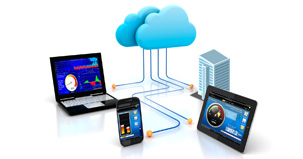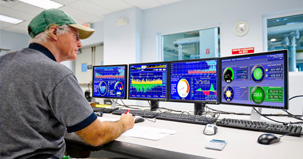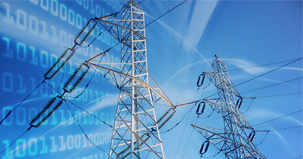- Home
- Smart Data
Smart Data
Actionable intelligence on energy and water use:
- Helps users identify inefficencies, and waste
- Provides real-time feedback on conservation
Right data for the right audience:
- Facility managers identify when and where energy is wasted
- CFO's can track and verify financial savings from initiatives
- Company knows its carbon and water footprint
Related Products
 Information any time, anywhere
Information any time, anywhere - Smart User
Smart User
Smart users leverage real-time data and reduce energy and water use by:
- Continuously identifying opportunities
- Acting on opportunities
- Tracking and verifying savings
- Sustaining savings
Related Products
 Monitor, Manage, Maintain
Monitor, Manage, Maintain - Smart Community
Smart Community
A smart community is one where all stakeholders are engaged in energy and water conservation. A smart community can be achieved by:
- Showing people precisely how much they are using
- Providing real-time feedback on conservation actions
- Effectively communicating efficiency results
Related Products
 Communicate and Conserve
Communicate and Conserve - Smart Grid
Smart Grid
Smart grid, as we define it, is a "green grid", with efficient resource use and the key to a low-carbon future. We help our customers prepare for the smart grid by:
- Engaging users with smart data
- Enabling smart users to increase resource efficiency
- Educating & empowering smart communities
Related Products
 Smart grid and a smarter future
Smart grid and a smarter future - Smart Buildings
Smart Buildings
Smart buildings maximize resource (energy, water, capital) efficiency. These buildings are optimized using energy and water management process with high data visibility which lead to reduced energy and water spending.
- Higher operating income and higher asset values for owners
- Increased productivity for occupants
- Lower carbon footprint for the community
 Resource efficient buildings
Resource efficient buildings
Recent Posts
Energy Monitoring: A Critical Piece of Going and Saving Green
Let’s say you have a million dollars. Of course, you want to make it grow, right? You ask around…find the right financial advisor…discuss your options. When you are absolutely sure you are comfortable with your new portfolio, you make your investments and never think about that million ever again. Right? Of course not!
Savvy individuals monitor their investments. Whether it’s a daily check of the markets, connecting with a broker on a regular basis or just perusing quarterly dividend statements, any investment worth making is worth watching.
When it comes to making a green investment in new construction or retrofitting an existing building, not having a way to monitor energy usage and savings is akin to walking away from that million and never looking back.
Neil Chambers, CEO and founder of New York City-based Chambers Design, Inc., said, “Monitoring must be a critical part of any green effort. You spend a lot of money to install your system and, if you are not monitoring it, you have no way of knowing if you are really getting the most out of it.”
Many companies that choose green buildings rely on energy bills to determine return on investment of a sustainable energy system. Chambers said, however, that monthly energy bills tell customers one thing: how much money to pay. What they don’t tell you is why you are paying that much, how you can be saving more energy and money, and whether or not you are making the most of your original investment.
Simply put, energy monitoring is an essential piece of green design, he added. “By monitoring your system, you can be sure you are away of your daily usage and energy expenses. You can track use and forecast energy needs. You can plan financially because you can use historical data to know what your costs are this month compared to next and year over year.”
Further, energy monitoring not only allows you to be certain that you are getting what you paid for but also allows you to immediately know when the system is not working at its best.
The Liberty Science Center, a 295,000 square foot museum in Jersey City, N.J., is a great case in point. The facilities manager wanted to know exactly how his building’s systems were operating in an effort to save money and energy. LSC installed Noveda Technologies web-based energy monitoring energy systems and discovered overnight that the facility was consuming three times more energy than originally estimated. By readjusting the night settings, daily electrical consumption was reduced by approximately 11 percent. The museum’s energy bills were reduced more than $700,000 and its carbon emissions were cut by 40 percent after only one year of energy monitoring.
Govi Rao, CEO of New Jersey based Noveda, said LSC is one of a host of customers who are serious about energy and cost savings and leveraged the data collected by his company’s systems to the fullest extent. “The Noveda system has been deployed and has been continually used to achieve sustained cost savings and lowering energy usage. It has helped LSC understand where they can save and continues to do that month over month and year over year.”
“Most buildings use more than one type of energy. You may have solar, electricity, natural gas, steam and others. All of those energies cost different amounts of money. A good energy monitoring system will tell you how much of which type of energy you are using and when you are using it,” Chambers said.
If you see you are using a particular type of energy more than the others, you can make changes in usage. System tweaks are easy and can save you untold dollars. But if you aren’t monitoring your system, you are operating blind.
Going forward, Chambers added, regular energy system monitoring allows you to make savvy financial decisions in other areas of your business – to save even more green. For example:
• Spikes in energy usage at various times of the day may cause you to initiate company-wide policies aimed at saving more energy such as automatic lights or shutting off monitors when not in use.
• You can track CO2 levels with employee performance and absenteeism, since air quality is known to impact productivity.
• And, going forward, a review of energy usage trends can offer ideas for ways to make changes to the system at a later date.
While the concept of keeping an eye on a major investment may seem obvious, Chambers said the idea of energy monitoring is relatively new to the general public.
“People want to go green but they see the monitoring part of it as an extra cost that they don’t want to pay for,” he said. “Truth is, they just don’t understand the value of energy monitoring. It’s a very
important extension of green design.”



